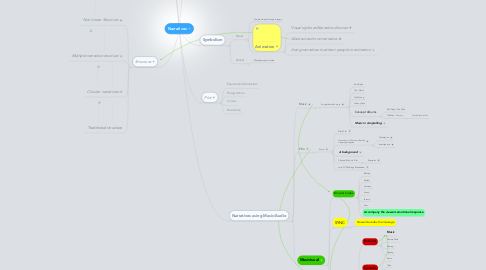
1. Structure
1.1. Non Linear Structure
1.2. Multiple narrative structure
1.3. Circular narratives
1.4. Traditional structure
2. Setting
2.1. Place
2.2. Time
2.3. Helps understand the characters
2.4. Create problems for characters
3. Cross Media/Transmedia Storytelling
3.1. Multimedia Storytelling
3.1.1. Facebook
3.1.2. Twitter
3.1.3. Youtube
3.1.4. Books
3.1.5. Websites
3.1.6. Mobile Phones
3.1.6.1. Eagle Eye
3.2. Articles
3.2.1. Extended Reality
3.2.2. Audiences are key
4. Character
4.1. Physical description
4.2. How the character acts
4.2.1. Protagonist
4.2.2. Antagonist
4.3. How others react to the character
5. Plot
5.1. Exposition/Intorduction
5.2. Rising Action
5.3. Climax
5.4. Resolution
6. Symbolism
6.1. Visual
6.1.1. Complex ideas through imagery
6.1.2. Animation
6.1.2.1. Visual styles as Narrative devices
6.1.2.2. Abstract and non-narrative
6.1.2.3. Using narratives to attract people in animation
6.2. Verbal
6.2.1. Metaphors and similes
7. Narratives using Music/Audio
7.1. Music
7.1.1. Songs that tell a story
7.1.1.1. Bob Dylan
7.1.1.2. Tom Waits
7.1.1.3. Neil Young
7.1.1.4. Johnny Cash
7.1.1.5. Concept Albums
7.1.1.5.1. Pink Floyd - The Wall
7.1.1.5.2. The Who - Tommy
7.1.1.6. Music in storytelling
7.2. Film
7.2.1. Score
7.2.1.1. Silent Film
7.2.1.2. How music in film can alter the viewers perception
7.2.1.2.1. Techniques
7.2.1.2.2. Investigation
7.2.1.3. A background
7.2.1.4. Classical Music in Film
7.2.1.4.1. Examples
7.2.1.5. Lord Of The Rings Breakdown
7.3. Musivisual
7.3.1. Musical Codes
7.3.1.1. Melody
7.3.1.2. Rhythm
7.3.1.3. Harmony
7.3.1.4. Sound
7.3.1.5. Texture
7.3.1.6. Form
7.3.1.7. Accompany the viewers emotional response
7.3.2. SYNC
7.3.2.1. Viewer decodes the message
7.3.3. Film Codes
7.3.3.1. Technical
7.3.3.1.1. Music
7.3.3.1.2. Camera Work
7.3.3.1.3. Framing
7.3.3.1.4. Lighting
7.3.3.2. Symbolic
7.3.3.2.1. Noise
7.3.3.2.2. Talks
7.3.3.2.3. Image
7.3.3.2.4. Colours
7.3.3.3. Conventions
7.3.3.3.1. Genres contain a set of conventions
